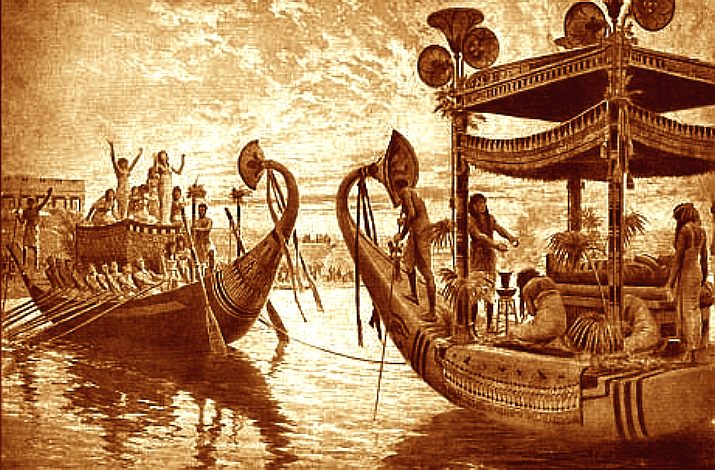The
archaeological evidence
The
slow flowing Nile was ideal for transportation and from
earliest times Egyptians built boats for transportation, fishing
and enjoyment.
Their importance in every day life is reflected in the role
they played in mythology
and religion.
Little
is left of actual boats. Remains of Old Kingdom boats were
found at Tarkhan and Abydos, and King Khufu's
ship is well known and demonstrates best how ships were
built during that period.
The
first dynasty boats found at Abydos were about 25 metres
long, two to three metres wide and about sixty centimetres
deep, seating 30 rowers. They had narrowing sterns and prows
and there is evidence that they were painted. They do not
seem to have been models but actual boats built of wood too
much decayed to analyse, some suspect that it was cedar,
others deny this.
Thick
planks were lashed together by rope fed through mortises.
The seams between them were caulked with reeds. The boats
did not have any internal framing and were twisted when they
were uncovered.
Egypt
abounds with pictures and models of boats and ships. The
walls of temples and tombs at Deir el Bahri and Medinet Habu
are covered with them, but very little is known, about how
New Kingdom ships were actually put together.
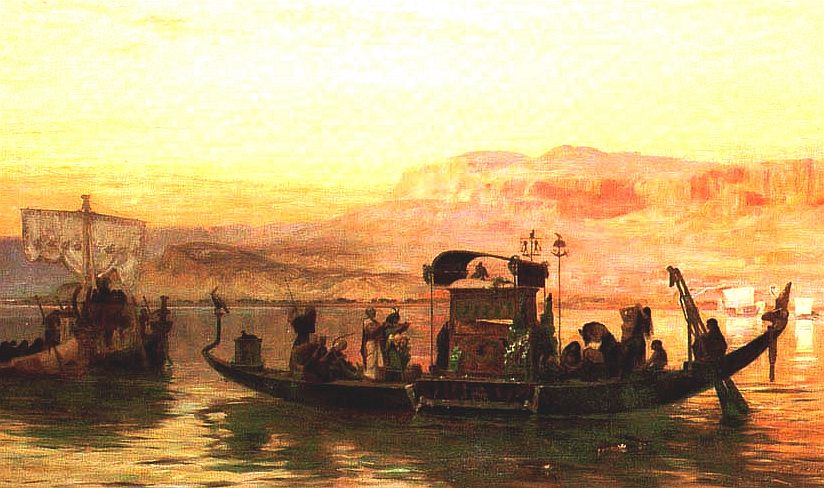
Queen
Cleopatra's royal barge, last of the Pharoahs
The
state involvement
A
number of pharaohs saw the need for a strong navy, i.e.
Snefru who according to the Palermo Stone built 100-cubit
ships of meru wood and 60 sixteen-barges before hacking
up the land of the Negro, bringing of 7,000 prisoners, and
200,000 large and small cattle, Thutmose
III, the architect of the empire in Asia, Necho
II struggling with the Babylonians and Ramses
III, who had to contend with the Sea Peoples. Ramses
wrote a 'report' to Amen
I
built you ships, freight ships, arched ships with rigging,
plying the Big Green (the sea). I manned them with
archers, captains and innumerable sailors, to bring the
goods of the Land of Tyre and the foreign countries at the
end of the world to your storage rooms at Thebes the
Victorious.
The
royal fleet was supervised by the Chief of the Royal
Ships, an important administrative rather than military
position, which under the 26th dynasty seems to have
included the responsibility for the taxation of merchandise
transported on the River
Nile.
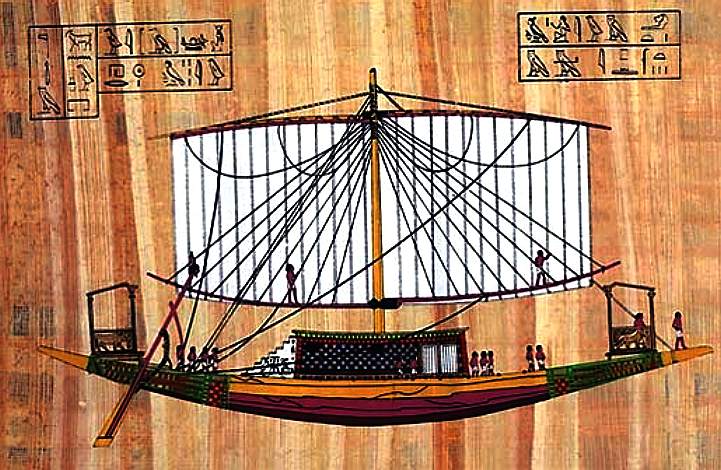
Under Thutmose III the butler Nebamen and under Amenhotep II
another butler, Suemniut, were given the office; and in a
later era of economical and political growth, the Saite
Period, the Overseer of the Scribes of the Magistrates
Tjaenhebu, and, under Ahmose II, Hekaemsaf and
Psammetik-mery-Ptah filled the post. A like title, Chief
of the Ships of the Lord of the two Lands, was bestowed
upon one Paakhraef.
Temple fleets were similarly organised: The priests of Amen
appointed a Chief of the ships of Amen, the servants
of Ptah a Chief of the Ships of the House of Ptah.
Egyptian
seagoing ships were inferior to those used by other peoples,
despite remarkable feats achieved, among them the
expeditions along the eastern coast of Africa during the
reign of Hatshepsut
at the beginning of the 15th century BCE and the crossing of
the Indian Ocean with seventy metre long ships in the times
of Ramses
III 300 years later. From the 20th dynasty onwards the
Egyptians began to copy ships used by their rivals.
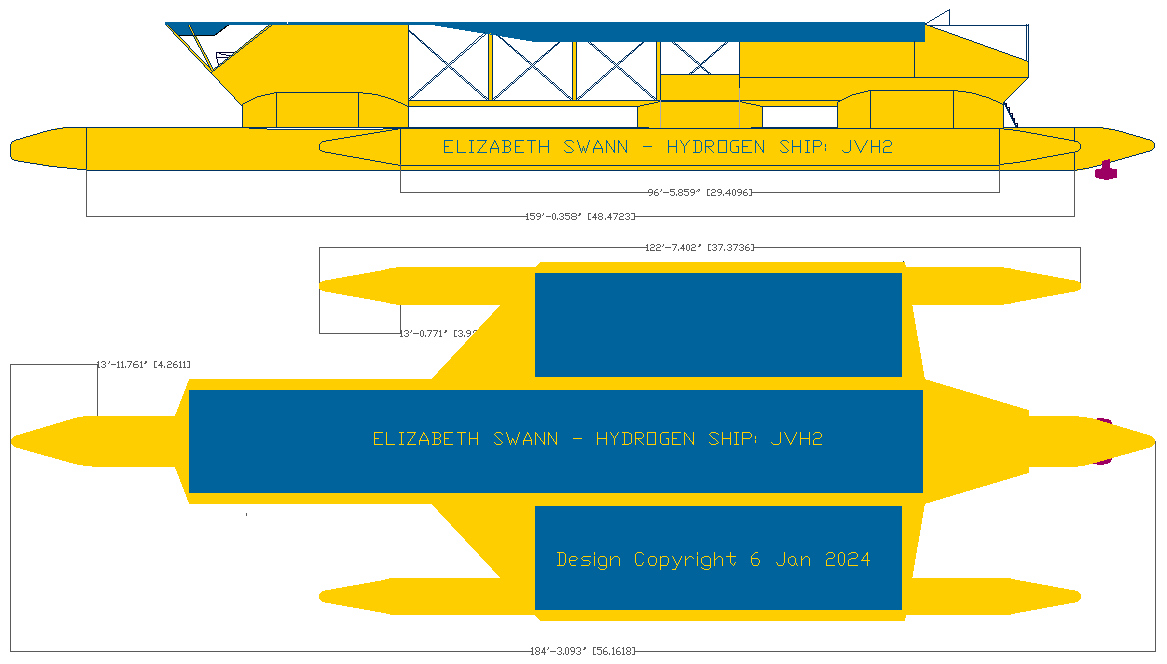
A
modern solar assisted ship, inspired by Queen Cleopatra and
the fictional character Elizabeth Swann. In line with the
practices in Ancient Egypt this ultra-modern trimaran uses
renewable energy to offer sustainable marine and river
transport. Thought to be the world's
fastest hydrogen ship.
Many trade and exploration ventures were initiated by the
administration, such as the voyages
to Punt under Hatshepsut and the circumnavigation
of Africa by Phoenician sailors under Necho.
Private ownership of ships existed at least during the First
Intermediate Period, documented by biographical
inscriptions. The weakness of the state and its consequent
inability to build ships needed for the transportation of
people and goods stimulated private enterprise.
During the Late Period Greeks and
Phoenicians spread along the Mediterranean coast, building
colonies. The Ionians
and Carians settled in the Delta and their centre of
Naukratis became an important port and was encouraged by a
number of pharaohs.
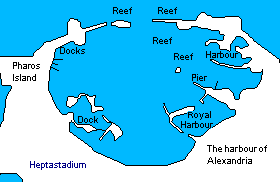
Alexandria
Harbour
Ship
construction
As
there was very little wood available, the first vessels were
made of bundled papyrus reeds. Simple rafts in the
beginning, they grew into sizable ships and were, as Thor
Heyerdahl proved with his ocean crossing, seaworthy. They
had a sickle shaped hull and often masts and sometimes
deckhouses.
Small papyrus rafts served the population throughout much of
Egypt's history, for as long as the raw material was readily
available. They were cheap to make and did not require great
expertise to build. Papyrus died out in Egypt and was
reintroduced in the 20th century.
Transportation
of heavy loads, international
trade and war
required stronger ships than could be built from papyrus.
These wooden vessels were similar in form to the old reed
boats, had a flat bottom and a square stern. As they were
without a keel onto which it could be stepped, the mast was
often bipod, fastened to the gunwhale. Later, under the
influence of Byblos, with which they were in close contact,
the Egyptians adopted a single central mast, which sometimes
was topped with a bronze finial to which the ropes were
tied. Instead of fitting rowlocks on the gunwhale to
keep the oars in place, rope
was used to serve as fulcrum. Smaller boats were paddled.
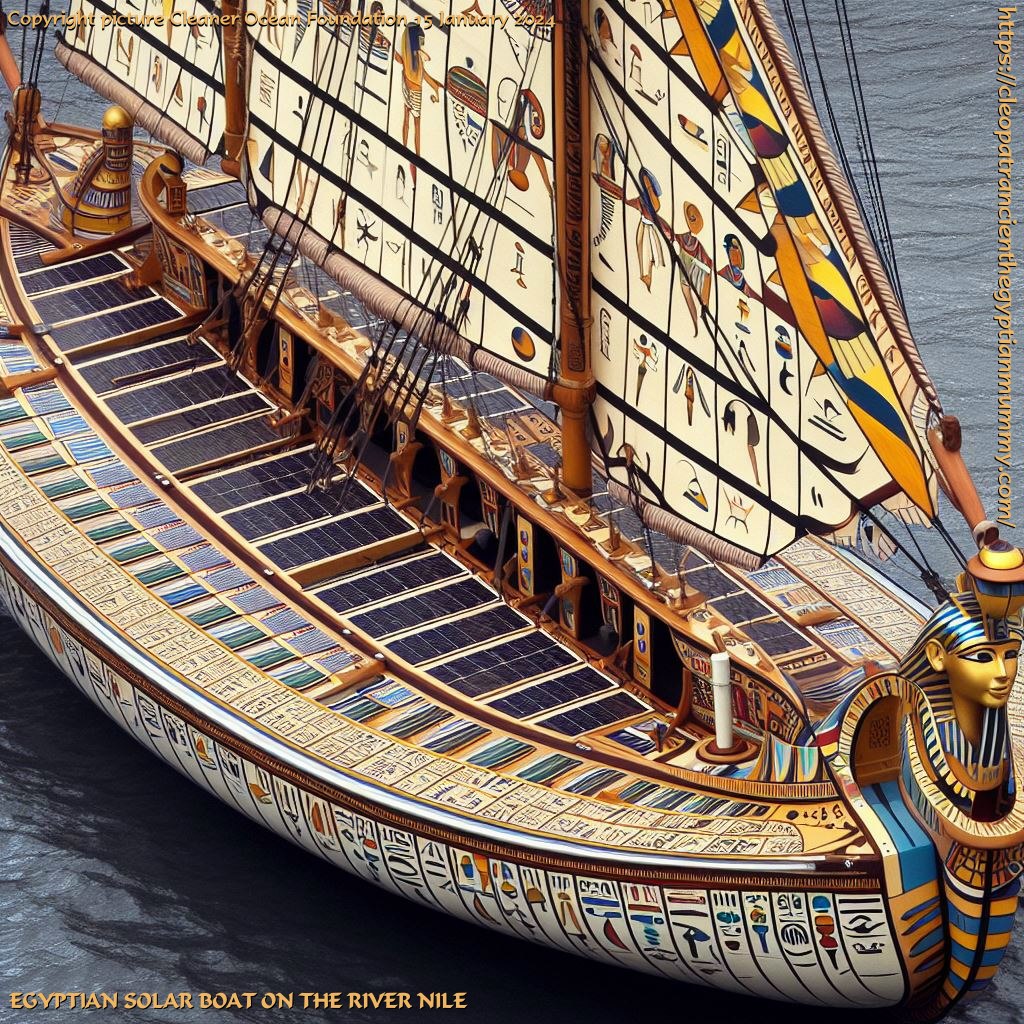
Herodotus
describes the building of a ship:
Their
boats with which they carry cargoes are made of the thorny
acacia, of which the form is very like that of the
Kyrenian lotos, and that which exudes from it is gum. From
this tree they cut pieces of wood about two cubits in
length and arrange them like bricks, fastening the boat
together by running a great number of long bolts through
the two-cubits pieces; and when they have thus fastened
the boat together, they lay cross-pieces over the top,
using no ribs for the sides; and within they caulk the
seams with papyrus. They make one steering-oar for it,
which is passed through the bottom of the boat; and they
have a mast of acacia and sails of papyrus. These boats
cannot sail up the river unless there be a very fresh wind
blowing, but are towed from the shore: from this acacia
tree they cut planks 3 feet long, which they put together
like courses of brick, building up the hull as follows:
they joined these three foot lengths together with long
close set dowels; when they have built up the hull in this
fashion they stretch crossbeams over them. They use no
ribs, and they caulk the seams from the inside, using
papyrus
Herodotus,
Histories II, Project
Gutenberg
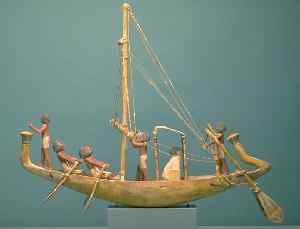
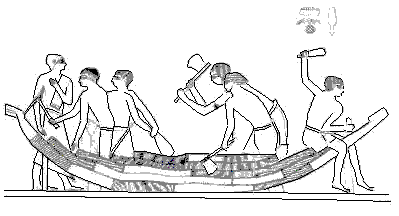
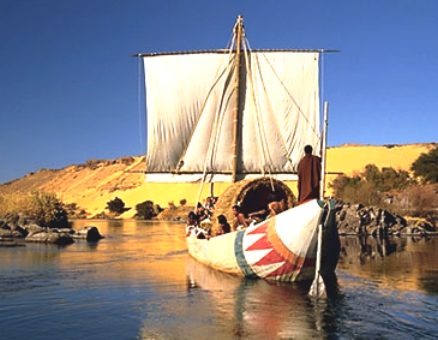
Egyptian
boat building - old and new
Sailing
the ships
The
river ships were propelled either by oar or sail, sometimes
they were towed or just left to drift downstream.
Down-stream
they travel as follows: they have a door-shaped crate made
of tamarisk wood and reed mats sewn together, and also a
stone of about two talents weight bored with a hole; and
of these the boatman lets the crate float on in front of
the boat, fastened with a rope, and the stone drags behind
by another rope. The crate then, as the force of the
stream presses upon it, goes on swiftly and draws on the
baris
(for so these boats are called), while the stone dragging
after it behind and sunk deep in the water keeps its
course straight. These boats they have in great numbers
and some of them carry many thousands of talents' burden.
Herodotus,
Histories 2, 96
During
the Old Kingdom, ships were steered with two large
unsupported oars held by helmsmen in both hands. Later the
oars were connected to tillers.
Even with this improvement steering was hard work. Amenhotep
II, a powerful man according to experts who examined his
mummy, was described thus
His
arms were strong and didn't get tired holding the oar and
steering in the stern of the king's ship, heading a crew
of 200 sailors. When the ship stopped after these men had
traversed half an
atur (about 5 km) they were left
without breath; their limbs were weak , they choked. But
His Majesty's strength didn't fail him steering with an
oar twenty cubits long. When he dropped anchor and tied up
the ship with a cable, he had traversed three atur
steering the ship without resting during the preparations.
The hearts of the people were glad seeing his
achievements.
In
Akhenaten's time the advanced brailed sail with small
ropes
on its edges for trussing came into use, making the furling
of the sail easier. There is archaeological and other
evidence that Egyptians adopted many practices of other
seafaring nations, such as the Phoenicians and Greeks. In
the Late Period Egypt came to depend to a high degree on
foreign ships and sailors.
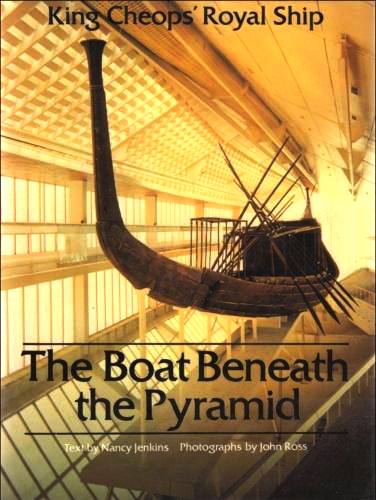
Constructions
facilitating navigation
While
the Mediterranean region was easily accessible to Egyptian
maritime traders, Eastern Africa was less so. Under Senusret
III (1850 BCE) and a number of other pharaohs, the last
being Ptolemy II, a canal
was being dug and redug connecting the Nile to the Bitter
Lakes, falling into disrepair during times of trouble. When
no canal was available ships had to be built so they could
be dismantled, carried overland through Wadi Hammamat to the
Red Sea and reassembled.
The Nile cataracts were obstacles that had to be dealt with.
A canal cut through rock enabled navigation beyond the first
cataract, and a slipway near the fortress of Mirgissa at the
second cataract has been found by archaeologists.
Dams
were built too, mostly with military aims in mind. The Sadd
el-Kafara in Wadi Garawi, the oldest known dam in the world,
collapsed not long after its erection. Another dam was
constructed at Semna probably during the reign of Amenemhet
III (1841-1796 BCE) and was in use until the times of
Amenemhet V, as the unusually high readings of the river
level - 8 metres above normal - seem to bear out.
The
Ionians settled at first on the Pelusian arm of the Nile,
where they beached their ships with the help of windlasses
as they were accustomed to do.
...
in the land from which they were removed there still
remained down to my time the winches with which their
ships were drawn up and the ruins of their houses.
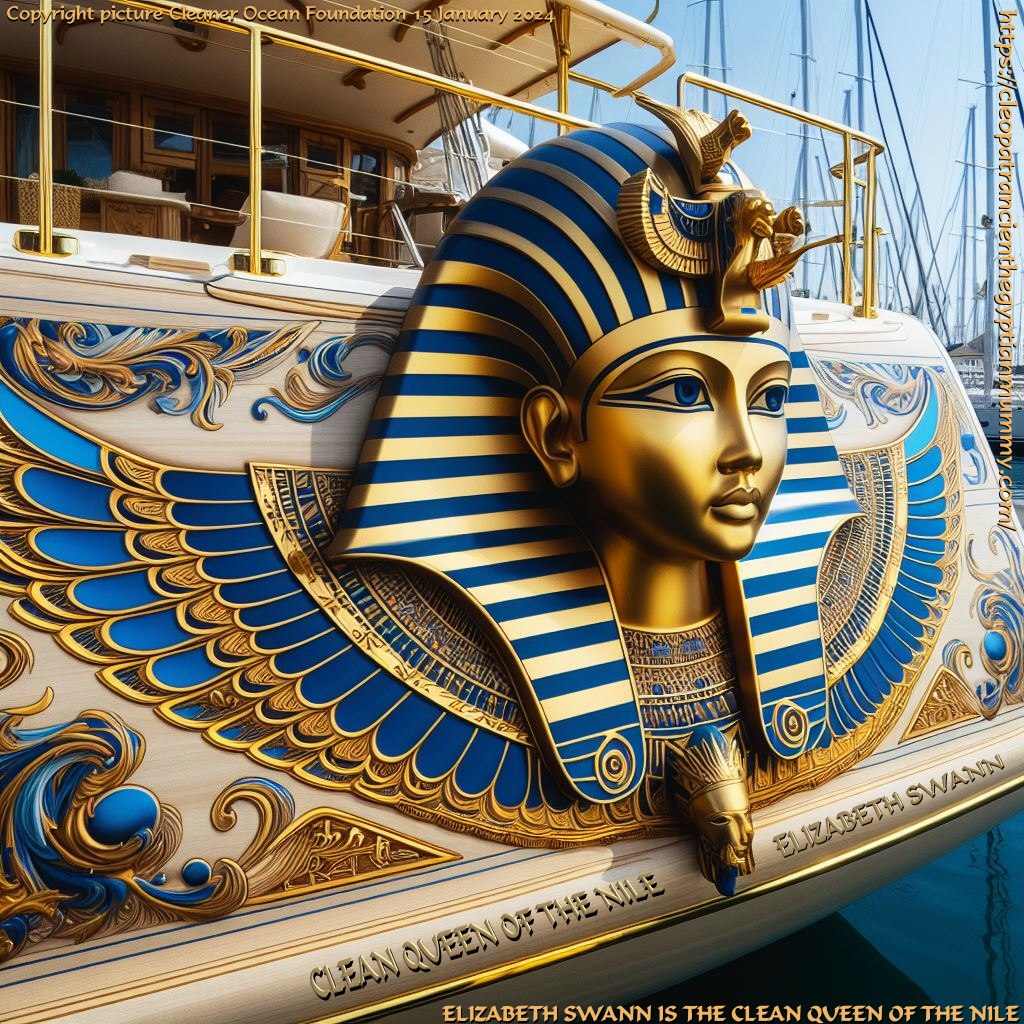
The
Pharos lighthouse of Alexandria, perhaps not the
first Egyptian lighthouse, though no records of any
earlier ones have been found, was built under Ptolemy Soter
from about 290 BCE till 270 at the entrance to what was to
become one of the most important ports of the Mediterranean.
Its height of more than 100 metres made it visible at
distances of about fifty kilometres.
During
day time a mirror was used to reflect the sun, at night a
fire was lit. The island of Pharos was later
connected to the mainland by the Heptastadium an artificial
isthmus which afforded better protection for the Port of
Pharos, later the East Harbour. Harbours and
quays were built along the Nile and the Mediterranean coast.
Especially important were well constructed quays in places
where heavy loads were shipped, near Qasr el Sagha on the
shore of Lake of Moeris for instance. From the quarry at
Widan el Faras blocks of basalt were transported to the quay
on a road with flagstone pavement. Cedar wood,
imported from Lebanon as long ago as the Early Dynastic
Period,
was much more suitable for shipbuilding than the local
acacia. Snefru's was recorded on the Palermo Stone.
During the second millenium BCE obelisks weighing 300 tons
were transported from Aswan downriver in ships specially
reinforced to carry such heavy loads.
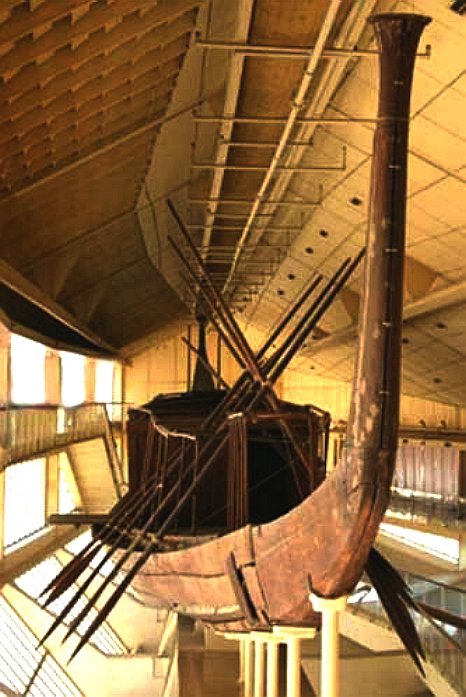
Egyptian
boat building - Khufu's royal barge - solar boat for the
afterlife
Seagoing
vessels
River
boats
Solar
ships and funerary boats
Early
ship construction and Khufu's solar boat
Navigable
canals
Voyages
of exploration
Index
of Topics
Main
Index and Search Page
[1]
Abydos boats
[2]
Helmsman on a boat in the tomb of Niankh-Pepi and Pepi-ankh
[3]
A Funerary Statuette of Hekaemsaf, Chief of the Royal Ships
in the Saitic Period by Gun Björkman
History
and archaeology of the ship - lecture notes by John Illsley
Ships
in Egypt: Pottery with pictures of ships (Naqada Period),
Timbers from Tarkhan, Old Kingdom scenes, wooden models (
Site of the UCL)
Bibliography
for preclassical seafaring
A
Selection of Model Boats from the tomb of Meketre.
The
lighthouse of Alexandria
Desert
Boats, Petroglyphs in the Eastern Desert
Abydos
Boat
Archaeologists
unearth Pharaonic solar barge
The
Ships of Antiquity
The
Carnegie Boat
After
5,000 year voyage, world's oldest built boats deliver
Cleopatra
Helen of
Troy Latin
Greek
Mythology Cleopatra
Pictures Rome
Ancient
Greece
Egypt
Indus
Valley Persian
Empire Judea
- Israel Queen
Cleopatra of Egypt
Documentaries
on Ancient Egypt Lower
Egypt Giza
Introduction
Pyramids
Tombs
The
Sphinx Solar
Boat Museum Upper
Egypt Middle
Egypt
The
design of Solar Navigator's figure
head is partly inspired by their beautiful Egyptian
Queen, Cleopatra.









